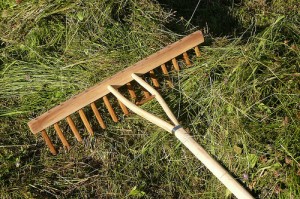Raking only needs to be done in the fall to remove leaves, right? Actually, you should plan on raking out your lawn at the start of every spring to give your grass the best possible start for the new growing season. This will help combat the effects of thatch and snow mold, which can both be problematic in the yard.
Thatch, Thatch Everywhere
As grass goes through its growing cycle, a layer of living and dead material called thatch forms above the top of the soil. It does not break down readily and can thicken over time. This can be a problem because it stops air, water and nutrients from easily reaching the roots. It can also harbor pests and diseases.
In addition to lawn aeration, the practice of raking out your lawn can cut down on the level of thatch present and allow for optimal grass growth. There is a special dethatching rake available that is designed for this purpose, but you can also use a regular garden rake. Make sure you get the tines down into the thatch as you rake so you can pull it up.
Snow Mold Can Cause Matted Grass
Did you know that there are some fungi out there that thrive in frosty conditions? Pink and gray snow molds can attack your grass even under a snowy layer, especially when there is a thick layer of thatch present. The lawn will begin to have clumps of matted grass that turn brown. Raking your lawn helps get rid of the snow mold spores and allows the grass to start repairing itself. Get rid of the raked grass so the spores do not have a chance to come back.
Give your grass a fresh start every spring by raking out your lawn. It will help you have the best conditions to produce grass that is lush and green.
Image by Nociveglia via a Flickr Creative Commons Attribution License



